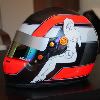- Login or Register
No account yet? Sign up






Different position on track. Look at background.Reventon wrote:this comparison is quite revealing
http://mclarenf-1.com/index.php?page=srs&s=11
if it is in a braking zone then the McL is further into it than the RB
Realy? Select RB7 vs Ferrarigilgen wrote:Different position on track. Look at background.Reventon wrote:this comparison is quite revealing
http://mclarenf-1.com/index.php?page=srs&s=11
if it is in a braking zone then the McL is further into it than the RB

Formula None wrote:
Still no full pics of the gearbox yet...
It wasn't a problem with debris: on the front, there was insufficient stiffness with the wishbones closer together, leading to pad knock-off, especially when going over kerbs.forty-two wrote:Formula None wrote:
Still no full pics of the gearbox yet...
Interesting location for the caliper. I thought they had decided putting it low down, while offering a CofG advantage, made it more likely for debris to get lodged in it following Sebs issues last year?
Assuming your talking about the wheel hub, there is a process for metal rapid prototyping, called Direct Laser Metal Sintering (DLMS) in fact this is how McL produced their rear floor and diffuser for the Australian GP.tok-tokkie wrote:How is that complex part made? It is beautifully finished. The titanium or aluminium thing the brake caliper is bolted to. Does not look like cnc machining. I suspect rapid prototyping of wax master then lost wax (spin?) casting. Is titanium easy to cast? Is there a process to rapid prototype directly into aluminium or titanium?
Well RB's amount of flexing isnt within the rules if you take it by the book...The fact that RedBull flexes without getting caught is another story.You can cheat and dont get caught,you are still a cheater though.gilgen wrote: Everybody knows that Newey is an innovator, and if the Red Bull has a flexing wing or nose, so what? Formula 1 is supposed to be about innovation within the rules, and in this case, McLaren seem to have missed the boat.
I guess that's possible. But given the size & geometry of a diffuser it seems like a sheet forming process would be more realistic. Where's the source confirming SLS was used vs. thermoplastic forming?Robbobnob wrote: Assuming your talking about the wheel hub, there is a process for metal rapid prototyping, called Direct Laser Metal Sintering (DLMS) in fact this is how McL produced their rear floor and diffuser for the Australian GP.
Yes, the upright appears to be CF with a Zircotec-type finish. Interesting, I assumed the uprights were still titanium parts. CF creeps into more stuff all the time.Robbobnob wrote: However for this part, the side of it has evidence of a carbon weave, leads me to believe it would be a heat protected carbon part.

The rear wing and camera mount heights on the RB7 are higher than the McL, which if you go to any side view comparison, is because the RB7 has a lot more rake. This rake helps to lower the front wing and change it's AoA. The rest is creative bits flexing a tiny bit here and there to lower it the rest of the way (possibly nose cone, uprights, etc).Mchamilton wrote:http://mclarenf-1.com/index.php?page=srs&s=7
in the lower image where the wings are aligned in the centre.. the tips of both are almost indentical in height, yet in the large image which is aligned to the tyres.. the red bulls entire wing is what looks to be at least 20mm lower than the mclarens.
nose cone flexing down?